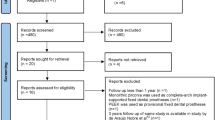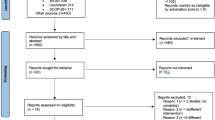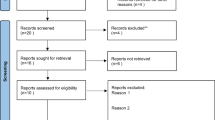Abstract
Purpose
The present systematic review was executed to evaluate the stress shielding effect of PEEK and its composite dental implants as compared to other implant (titanium and zirconia) materials in peri-implant bone.
Materials and method
The comprehensive online literature search was conducted on PubMed, Google Scholar, and Web of Science from January 2011 to January 2023. A total of 43 in vitro studies were identified related to the raised question. In all, 34 studies were excluded as they included in vitro studies focusing on stress distribution in prosthesis framework, abutments, crown, and on biological properties such as cell adhesion, etc. Only eight studies after full-text screening were included in the present systematic review.
Results
The data extracted from included studies showed that PEEK and its composite materials, have a less stress shielding effect due to their low modulus of elasticity resulting in higher stress concentration and strain in the peri-implant bone as compared to titanium and zirconia implant materials.
Conclusion
The PEEK and its composites can be used as an alternative material in the esthetic region and in those who have an allergy to metal implants. However, due to the low elastic modulus of PEEK, a homogenous stress distribution is not observed along the entire length of the implant. Further studies are required to improve the composition of PEEK material so that a homogenous reduction of stress shielding effect along the whole length of a dental implant can be achieved.
This is a preview of subscription content, access via your institution
Access options
Subscribe to this journal
Receive 4 print issues and online access
$259.00 per year
only $64.75 per issue
Buy this article
- Purchase on Springer Link
- Instant access to full article PDF
Prices may be subject to local taxes which are calculated during checkout

Similar content being viewed by others
References
Hosoki M, Nishigawa K, Miyamoto Y, Ohe G, Matsuka Y. Allergic contact dermatitis caused by titanium screws and dental implants. J Prosthodont Res. 2016;60:213–9. https://doi.org/10.1016/j.jpor.2015.12.004.
Kim KT, Eo MY, Nguyen TTH, Kim SM. General review of titanium toxicity. Int J Implant Dent. 2019;5:10. https://doi.org/10.1186/s40729-019-0162-x.
Goutam M, Giriyapura C, Mishra SK, Gupta S. Titanium allergy: a literature review. Indian J Dermatol. 2014;59:630. https://doi.org/10.4103/0019-5154.143526.
Huiskes R, Ruimerman R, Van Lenthe GH, Janssen JD. Effects of mechanical forces on maintenance and adaptation of form in trabecular bone. Nature. 2000;405:704–6.
Brown IW, Ring PA. Osteolytic changes in the upper femoral shaft following porous-coated hip replacement. J Bone Joint Surg Br. 1985;67:218–21.
van Steenberghe D, Quirynen M, Naert I, Maffei G, Jacobs R. Marginal bone loss around implants retaining hinging mandibular overdentures, at 4-, 8- and 12-years follow-up. J Clin Periodontol. 2001;28:628–33.
Esposito M, Hirsch JM, Lekholm U, Thomson P. Biological factors contributing to failures of osseointegrated oral implants. (II). Etiopathogenesis. Eur J Oral Sci. 1998;106:721–64.
Abrahamsson I, Berglundh T. Effects of implant surfaces and designs on MBL alterations. Clin Oral Implants Res. 2009;20:207–15.
Lee CK, Karl M, Kelly JR. Evaluation of test protocol variables for dental implant fatigue research. Dent Mater. 2009;25:1419–25.
Wiskott HW, Nicholls JI, Belser UC. Stress fatigue: basic principles and prosthodontic implications. Int J Prosthodont. 1995;8:105–16.
Geng JP, Tan KBC, Liu GR. Application of finite element analysis in implant dentistry: a review of the literature. J Prosthet Dent. 2001;85:585–98.
Fabris D, Moura JPA, Fredel MC, Souza JCM, Silva FS, Henriques B. Biomechanical analyses of one-piece dental implants composed of titanium, zirconia, PEEK, CFR-PEEK, or GFR-PEEK: Stresses, strains, and bone remodeling prediction by the finite element method. J Biomed Mater Res B Appl Biomater. 2022;110:79–88. https://doi.org/10.1002/jbm.b.34890.
Schwitalla AD, Abou-Emara M, Spintig T, Lackmann J, Müller WD. Finite element analysis of the biomechanical effects of PEEK dental implants on the peri-implant bone. J Biomech. 2015;48:1–7. https://doi.org/10.1016/j.jbiomech.2014.11.017.
Lee W-T, Koak J-Y, Lim Y-J, Kim S-K, Kwon H-B, Kim M-J. Stress shielding and fatigue limits of polyether-ether-ketone dental implants. J Biomed Mater Res B Appl Biomater. 2012;100B:1044–52.
Haseeb SA, Vinaya KC, Vijaykumar N, Sree Durga BA, Kumar AS, Sruthi MK. Finite element evaluation to compare stress pattern in bone surrounding implant with carbon fiberreinforced poly-ether-ether-ketone and commercially pure titanium implants. Natl J Maxillofac Surg. 2022;13:243–7.
Mourya A, Nahar R, Mishra SK, Chowdhary R. Stress distribution around different abutments on titanium and CFR-PEEK implant with different prosthetic crowns under parafunctional loading: A 3D FEA study. J Oral Biol Craniofac Res. 2021;11:313–20. https://doi.org/10.1016/j.jobcr.2021.03.005.
Tamrakar SK, Mishra SK, Chowdhary R, Rao S. Comparative analysis of stress distribution around CFR-PEEK implants and titanium implants with different prosthetic crowns: a finite element analysis. Dent Med Probl. 2021;58:359–67. https://doi.org/10.17219/dmp/133234.
Sarot JR, Contar CM, Cruz AC, de Souza Magini R. Evaluation of the stress distribution in CFR-PEEK dental implants by the three-dimensional finite element method. J Mater Sci Mater Med. 2010;21:2079–85. https://doi.org/10.1007/s10856-010-4084-7.
Kurtz SM, Devine JN. PEEK biomaterials in trauma, orthopedic, and spinal implants. Biomaterials. 2007;28:4845–69.
Carpenter RD, Klosterhoff BS, Torstrick FB, Foley KT, Burkus JK, Lee CSD, et al. Effect of porous orthopaedic implant material and structure on load sharing with simulated bone ingrowth: A finite element analysis comparing titanium and PEEK. Journal of the mechanical behavior of biomedical materials 2018;80:68–76.
Qin W, Li Y, Ma J, Liang Q, Tang B. Mechanical properties and cytotoxicity of hierarchical carbon fiber-reinforced poly (ether-ether-ketone) composites used as implant materials. J Mech Behav Biomed Mater. 2019;89:227–33.
Kurtz SM, Devine JN. PEEK biomaterials in trauma, orthopedic and spinal implants. Biomaterials. 2007;28:4845–69.
Minatel L, Verri FR, Kudo GAH, de Faria Almeida DA, de Souza Batista VE, Lemos CAA, et al. Effect of different types of prosthetic platforms on stress-distribution in dental implantsupported prostheses. Mater Sci Eng C Mater Biol Appl. 2017;71:35–42.
Faverani LP, Barão VA, Ramalho-Ferreira G, Delben JA, Ferreira MB, Garcia Júnior IR, et al. The influence of bone quality on the biomechanical behavior of full-arch implant-supported fixed prostheses. Mater Sci Eng C Mater Biol Appl. 2014;37:164–70.
Frost HM. A 2003 update of bone physiology and Wolff’s Law for clinicians. Angle Orthod. 2004;74:3–15.
Liu T, Chen Y, Apicella A, Mu Z, Yu T, Huang Y, et al. Effect of porous microstructures on the biomechanical characteristics of a root analogue implant: an animal study and a finite element analysis. ACS Biomater Sci Eng. 2020;6:6356–67.
Schwitalla AD, Zimmermann T, Spintig T, Kallage I, Müller WD. Fatigue limits of different PEEK materials for dental implants. Journal of the mechanical behavior of biomedical materials. 2017;69:163–8.
Bataineh K, Al Janaideh M. Effect of different biocompatible implant materials on the mechanical stability of dental implants under excessive oblique load. Clin Implant Dent Relat Res. 2019;21:1206–17.
Georgiopoulos B, Kalioras K, Provatidis C, Manda M, Koidis P. The effects of implant length and diameter prior to and after osseointegration: a 2-D finite element analysis. J Oral Implantol. 2007;33:243–56. https://doi.org/10.1563/1548-1336(2007)33[243:teoila]2.0.co;2.
Pessoa RS, Muraru L, Júnior EM, Vaz LG, Sloten JV, Duyck J, et al. Influence of implant connection type on the biomechanical environment of immediately placed implants - CT-based nonlinear, three-dimensional finite element analysis. Clin Implant Dent Relat Res. 2010;12:219–34. https://doi.org/10.1111/j.1708-8208.2009.00155.x.
Pashley DH, Agee KA, Wataha JC, Rueggeberg F, Ceballos L, Itou K, et al. Viscoelastic properties of demineralized dentin matrix. Dental Mater. 2003;19:700–6.
Sheets CG, Earthmann JC. Natural tooth intrusion and reversal in implant-assisted prosthesis: evidence of and a hypothesis for the occurrence. J Prosthet Dent. 1993;70:513–20.
Mobilio N, Stefanoni F, Contiero P, Mollica F, Catapano S. Experimental and numeric stress analysis of titanium and zirconia one-piece dental implants. Int J Oral Maxillofac Implants. 2013;28:e135–42. https://doi.org/10.11607/jomi.2335.
Author information
Authors and Affiliations
Contributions
VV: concept design, data collection, data analysis and interpretation, drafting of article, critical revision, and approval of article. PH: data analysis and interpretation, drafting of article, critical revision, and approval of article. PV: drafting of article, critical revision, and approval of article.
Corresponding author
Ethics declarations
Competing interests
The authors declare no competing interests.
Additional information
Publisher’s note Springer Nature remains neutral with regard to jurisdictional claims in published maps and institutional affiliations.
Rights and permissions
Springer Nature or its licensor (e.g. a society or other partner) holds exclusive rights to this article under a publishing agreement with the author(s) or other rightsholder(s); author self-archiving of the accepted manuscript version of this article is solely governed by the terms of such publishing agreement and applicable law.
About this article
Cite this article
Verma, V., Hazari, P. & Verma, P. Do implants made of polyetheretherketone and its composites have reduced stress shielding effects compared to other dental implant materials? A systematic review. Evid Based Dent 24, 193–194 (2023). https://doi.org/10.1038/s41432-023-00935-y
Received:
Accepted:
Published:
Issue Date:
DOI: https://doi.org/10.1038/s41432-023-00935-y



